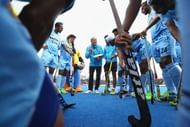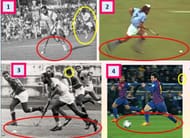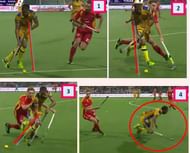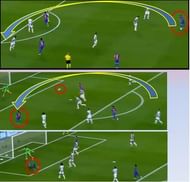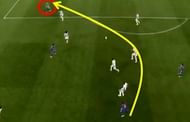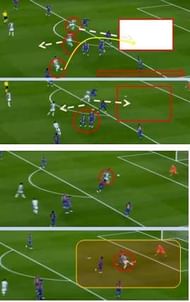To answer this burning question, I like these Time Tested Universal Principles, to advocate and evaluate the current situation, improvement and performance of the former champions; India:
In the May 2016 issue of the Harvard Business Review magazine Meg Whitman, CEO of Hewlett – Packard (HP) was interviewed by its editor in chief Adi Ignatius. She made the following comments while referring to how she successfully turned around HP in a short span of 5 years.
“So we set out on a turnaround journey, which I predicted would take five years. I said ‘What are the core values of this company? Let’s identify what it does really well and do more of that as the anchor for the turnaround. Then let’s make a to-do list for the things to be fixed.’ So we went back to our core founding principles, and the company responded.
“You need the right people in the right jobs at the right time with the right attitude. That sounds easy, but it’s very hard.
“The great thing about team sports is that you don’t win unless everyone plays her position. Have you ever watched a bunch of five-year-olds play soccer? They all go with the ball, and it’s not very effective.
“The ability to play defence and offence, to know your position, to know what you’re accountable for—all of that is learned by doing, for me, that ‘all for one, one for all’ approach, led by a coach, was part of how I learned to lead.”
BTW, Meg played field hockey during her college days.
“What things you are not going to do. That is the most difficult decision for companies, because we all have eyes that are bigger than our stomachs.”
In other words, what are one’s strengths? Is the right player playing in the right position? Does one know and understand his/her role and responsibility? What to do and what exactly not to do?
Improvements
Before analysing that have these principles been implemented or not, it is important to look at what has improved and being done very well? As it has resulted in bringing positive changes and help India crawl out of the slump and be on its turnaround journey. Thanks to the foreign coaches, their knowledge and sacrifices.
It is hard to also not think of the Punjab Institute of Sports, which has developed more than 50% of the players on the current Indian senior national team and the 2016 Junior World Cup winning team, under the leadership of Sukhvir Singh Grewal.
Here is the list of the things, Indian Hockey team is doing very well.
Tactical
- Team structure, especially in the back four
- Circulating the ball in the back
- Press Tactics as a team
- Defending and attacking as a team
- Marking individually and as a team
- Interchanging Positions during the run of play
Technical
- Back checking or reverse tackling by the forwards
- Aerial hockey
- Sweeps from the strong and weak side
- Overall basic skills
Physical
- Vastly Improved physical fitness which is a tremendous plus
- Collective teamwork rate very high
Psychological
- Improved attitude
- Positive self-expectancy
- Self-discipline
- Self-belief
- Team unity
- Work ethic
- Desire to learn and excel
Management
- Improved planning and organisation
Goal scoring
- Especially via Tomahawks
- Deflections and rebounds
Set Plays
- Improved penalty corner conversion rate
Goalkeeping
- Vastly Improved department and a big reason for team’s success
- Fewer soft goals are allowed now
S.W.O.T. Analysis
When a new Head Coach takes reins of a team, he usually looks at the Strengths, Weakness, Opportunities and Threats in regard to the team’s present form. A critical question which must be asked is, what needs to be done?
What did India need to improve?
India’s weaknesses from the beginning of the 90’s, until the late part of the previous decade, was basically not being able to upgrade their technical and tactical skills to keep up with the changing times. They completely ignored the use of science and technology to a large extent during this period.
For example, how to blend direct and indirect hockey. India were playing very direct, especially from their 16-yard offensive free hits.
This was one of the key reasons why India did not qualify for the 2008 Beijing Olympics. During the qualifier in Chile, against Great Britain, in the final match, India kept on taking direct hits on the offensive 16s, while trying to penetrate the ball through the GB defence, which stood strong like a wall.
This not only resulted in them conceding possession to GB but also allowed the Britishers to control the game via circulating the ball at will. The reason behind this being India’s press tactics, which as a unit was basically nonexistent.
Here are some other areas where team India needed to improve themselves.
- Circulating the ball in the back
- Implementation of press tactics
- Playing as a unit
- Back checking/reverse tackling
- Running off the ball to create spaces
- Interchanging positions and marking
- Lethargic attitude of some senior players and a couple of coaching staff members
- Below average goal-keeping
- Sub-par rate of penalty corner conversion
Players – especially forwards – loved to run with the ball on their own and then ultimately lose it, after dodging one, two or three opponents. To add insult to injury, they strolled back without any urgency to get back the ball.
So the question is, were India really as bad as was depicted by the foreign coaches and gurus? Especially after the 2008 Olympic Games, when India failed to qualify for the Olympics for the first time. I don’t think so!
In spite of all the above-mentioned weaknesses, India were very close to qualifying for the semifinals of the below-mentioned Olympic Games. An extra goal or an extra win in a pool match would have certainly helped them achieve the same.
1996 Atlanta Olympics: Finished 8th
2000 Sydney Olympics: Finished 7th
2004 Athens Olympics: Finished 7th
The foreign coaches, even until today, have not been able to surpass the results which the Indian coaches were able to achieve prior to the Beijing debacle.
2008 Beijing Olympics: Did not qualify
2012 London Olympics: Finished 12th and last under Head Coach Michael Nobbs
2016 Rio Olympics: Finished 8th under Head Coach Roelant Oltmans
Therefore, the bigger question here is why India have not been able to crack the top six or four bracket in the last two Olympic Games and World Cups despite having foreign coaches, getting all the technical support, world class training facilities and what not.
This brings us to the burning question of this article, is India operating upon the right principles, strategies and tactics?
In a way, yes. India are doing so, to a certain extent.
What they need is a strategic course correction, which will facilitate and optimise their unique strengths. What they have though is technical brilliance, which no other country, except Pakistan and Australia, has ever had.
They are simply not being coached to play to their optimum. They are coached and encouraged to play a style which operates more along the lines of speed and brute force – tilting more towards the European style of play and moving away from their forte of technical brilliance.
*I would like to make this absolutely clear that there is nothing wrong with the European style of play. European coaches have intelligently leveraged their unique strengths and the outstanding performances of Germany, Netherland and Belgium speak for themselves.
However, the question is, does it blend well with India’s unique strength and style of play? What should one embrace and discard?
Coach Oltmans, prior to the 2017 Azlan Shah Cup, commented, “Our style will be very much Indian.” With all due respect, this might be true in theory, but not in practice.
Just to be clear, when I say technical brilliance, I don’t mean the players who over dribble and hang on to the ball unnecessarily. I am talking about players like Balbir Singh and Harbinder Singh, from the Railways, Olympic Gold and Bronze medal winners, who were way ahead of their times in the 60’s.
They knew exactly how to cleanly eliminate the defenders, with their body feints, stick feints, change of pace and direction, all on the run. The rumour has it that both these forwards ran the 100 meters sprint under 11 seconds, whereas Bob Hayes, gold medal winner of the 1964 Tokyo Olympics, ran the 100 Meter sprint in 10 seconds.
What we can learn from the past
The collage above depicts Balbir, running gracefully with the ball in images 1 and 2. Harbinder (3), Balbir and Messi are running with the ball in almost the same style. They are not afraid to expose it by keeping it in front of them. Sometimes, they deliberately make it a common ball, to entice a defender to commit and take a bait.
Another thing worth noticing here is that there are no defenders near these players. If you see any, they are chasing in desperation (yellow circle). The secret is that the masters know how to shake and dump them before they even come closer.
Comparative Analysis of the photo sequences
In the collage above, SV Sunil, current member of the Indian national team and a right winger/striker by trade is over protecting the ball while running in a straight line, with his head down. He finally gets fouled upon but the same time, the Indian should not blame anyone but his coaches, who have taught him this style of running with the ball.
He is lacking the finesse to change the pace and direction while selling dummies.
Going back to the 70s, Pakistan produced highly intelligent and effective players, namely Manzoor Junior, Kaliumullah and Shabaz Senior, who single-handedly helped their teams win Olympic Gold medals and world titles.
This was also an era when the Europeans and Oceanic teams had improved tremendously while implementing scientific training methods to close the knowledge and performance gap.
On a side note, sadly Australians have also driven away from their unique strengths of technical brilliance, which always gave them the winning edge.
Their shocking defeats at the hands of Japan and Great Britain, during the recently concluded 2017 Azlan Shah Cup, have raised quite a few eyebrows. However, they did miss their star captain and ageing Mark Knowles due to injury.
A key question to be asked during the strategic planning sessions
“If you don’t stand for something you will fall for anything.”
- Peter Marshall
Can India defeat Germany, Holland and Belgium by completely playing their opponents’ style of hockey and not using their unique strengths of soft skills and finesse? Yes, once in a while, India can, but the odds are not entirely, in their favour. In the recent past, they have been able to match them for certain periods of the game. But in the end, they have been wrestled down.
One should not blindly – knowingly or unknowingly – follow rival’s strategies and tactics. This is an easy way to fall in their trap.
Comparative Analysis
“The player who is bigger, stronger and faster… may learn to solve football problems on the pitch with brute force rather than skill and finesse.”
- Mark Upton, Coaching Science Manager, English Institute of Sports
When I look at the Indian Men’s national team’s performance under the leadership of current Head Coach Roelant Oltmans, and his predecessors, namely, Paul Vann Ass, Terry Walsh, Michael Nobbs and Jose Brasa, I see a lot of positive changes, which were brought during the past 8-9 years.
At the same time, some of the strategies, tactics, coaching philosophies, actions and decisions made by them were not the wisest. The only reason being they did not align with the Indian teams’ unique strengths.
The principles mentioned in the beginning were strictly followed by the highly effective CEO, Meg Whitman. No wonder she turned around the derailed and badly damaged Hewlett-Packard Company in five years.
Has Coach Oltmans been able to do so? He is quite close, but still not there. There is always a slip between a lip and a cup, especially, when you are not holding the cup the correct way.
Let’s see how Coach Oltmans has applied these principles to the Indian team.
Principle #1: Identify one’s strength and use it as the anchor
Indian team’s biggest strength was soft skills, ball control, play making moves, finesse, change of pace/direction, one on one elimination skills in a confined space, and playing one-touch hockey. All the foreign coaches, rather than recognising, complementing and building upon them, have sharply deviated from them.
They have developed a different style of play, which does not completely takes into consideration India’s unique strengths.
“In teaching, teachers will most likely teach in the way they were taught, rather than the way that is most successful and effective.”
With all due respect, these world class coaches may know the value of the soft skills and admire them but unfortunately, they don’t understand them deep down. And a know-how to effectively teach them either. Their coaching philosophy and training methods are different, which sharply deviate from developing soft skills.
There is nothing wrong with their training methods but one needs to observe that do these philosophies fit into the scheme of things while embracing the players’ strengths?
Here is one of the very rare photographs of Coach Oltmans demonstrating a skill prior to the 2017 Azlan Shah Cup. It looks like he is explaining how to receive a ball in a neutral stance, which is different than what the former Indian hockey gurus used to teach.
Basically, this flat-footed stance does not facilitate the optimum growth of soft skills. But it sure does promote the execution of other vital skills of the game, adapted by the rival teams.
Principle #2: The right people in the right jobs at the right time and with the right attitude
Is the player playing in his favoured position?
Let’s take the example of Sardara Singh. He had been playing as a centre-half for a long time but Coach Oltmans's decision to play him as a right-inner during the 2016 Rio Olympics was not a step in the right direction. This made a highly intelligent player like Sardara underperform.
He couldn't transfer his distribution skills from the centre-half position to the right inner position. During the early part of his career, Sardara did play as a right inner but now, he was playing in a totally different system.
Please remember: In the Indian hockey system, a centre-half is the heart of the team and right inner its brain. They have entirely different roles and style of play in the system, just like the organs in our bodies. One distributes the blood (ball) and the other thinks, processes the information and makes wise decisions (playmaker)
Think of Xavi as Barcelona’s centre-half and Messi as its right inner. Their tactical thinking and strategic style of play are based upon this very philosophy.
Messi has dropped back from his forward position, where he starts the game. He is playing more or less as a right inner or a left inner to make defence-splitting passes for his forwards, Neymar and Luis Suarez to score field goals.
Photo #1 shows Messi being challenged by three Juventus opponents while executing semi-penetrating moves. Further, after reading the game situation, he calmly makes one aerial lob pass to eliminate eight opponents. This has resulted in creating a one on one goal scoring opportunity for Iniesta against the goalkeeper.
Yes, we do this too in field hockey but with such brute force that often the rabbit is killed, even before it is pulled out of the hat. Implementing ‘hit and hope’ strategy near opponents 23 meters zone.
Scientists call this “Pattern Recognition and Recalling”. Our – Patterns of play - in field hockey are of a different type. They simply kill the opponents with brute force, rather than softly with love.
Principle #3: The ability to play in both defence and offence
Does one know and understand his/her role and responsibility?
When Terry Walsh, former Indian national team Head Coach, coaxed Gurbaj Singh to play as a centre-forward prior to the 2014 Asian Games, this is what the former Indian player had to say, “The right-half is a position where I am comfortable. I know exactly when I have to move forward, when to attack or when the team needs me in defence.
“I know exactly when to send a dummy pass and where to find the forward.If I had to suddenly play as a forward, I would have had to learn all this positioning once again. I already had that rhythm in my old position. So I told the coach that I would be able to contribute better to the team if I played in my old position,”
According to Jonathan Salvraj, who interviewed Gurbaj, “It would prove to be a wise decision. At the Asian Games, which India won after a gap of 24 years, much of the team’s performance can be credited to the midfield trio. Gurbaj himself was one of the standout performers of the squad, repeatedly creating openings on the right flank.
“But as intelligent as it was, Gurbaj’s choice to back his ability against the coach’s perception was equally brave. Having finally made a comeback to the squad, Gurbaj admits he owes a debt to Walsh”.
Gurbaj added, “It was a risk for Coach Walsh, to pick me in the side after a long gap. I felt that I needed to deliver on the trust that was placed on me.”
Coach Oltmans also moved Sardara from his centre-half position to right-inner during the 2016 Rio Olympics. In the same way Coach Nobbs moved Gurbaj from his right-half position to right winger/right inner during the 2012 London Olympics. And this did not help these outstanding players to perform at their peak.
Fair criticism?
We hear from the foreign coaches that Indian players have a big weakness of not being versatile. In theory, this is correct, but practically? Will Mark Knowles from Australia be able to play as a centre-forward from his deep defensive position or Jamie Dwyer be able to play as a deep defender from his forward position?
Yes, they can play, but not to the same degree of effectiveness. Think about it? Is this a fair criticism?
However, I agree that every player needs to be versatile and should be able to read the game from different angles and positions, to shift their mental gears and make intelligent decisions accordingly. But this will depend upon the ever-changing game situations, especially when a player has overlapped or interchanged his position to execute the game plan.
Principle #4: What not to do?
In my opinion, the first thing which is not to be done is running with the ball in a straight line. A majority of the time, when players get the ball, especially in the mid and the third quarter of the field, they end up running in straight lines.
However, there is a definite time and place for it. One should first read the game situation, weigh all the options available and then make the decisions accordingly.
Who can run faster the ball or the player?
Once the players learn the art of making the ball run, via playmaking passing skills, they will do themselves a huge favour. This will also facilitate playing one-touch hockey, which India was famous for during their golden era.
This photograph is from the 2017 Azlan Shah Cup when India played Malaysia in their last pool match, which they lost. Here we see Sardara Singh running with the ball at full speed and bulldozing his way with force, rather than with grace. Note his left elbow, pushing the opponent.
Sardara could have easily slowed down – changed the pace and direction – and shuffle to his right, to create more space and time. He used to do this so well and now he is running with the ball - slightly panicked - when being challenged by the opponent.
If you drive recklessly, you end up where the red car is. Think about it!
“It’s (Tactical Creativity) not the ability to see where everyone is when you look, (but) where everyone will be if you buy some time and hold the puck for another second.”
-Sidney Crosby, Captain Pittsburg Penguins ice hockey team in the NHL
Here is another example from the Barcelona versus Juventus 2nd leg UCL quarterfinals match, dated 19 April 2017, which clearly elaborates Sidney’s point.
You can see how the Juventus right inner holds the ball for a split second to make a pass for his leading striker and take a try on the goal. Also observe how the striker floats back, while enticing two Barca defenders to follow him and creating space for his teammate to enter from the back.
Sadly we miss this types of creative plays in our game of hockey. They are few and far in-between.
Seeing things from the players’ perspective
These days, as soon as a player gets the ball, opponents pounce upon him like a pack of wolves, giving him no space and time. And out of fear, the player runs at full speed, just as a beautiful lady panics and runs, when approached by three thugs in a dark alley.
If you have the guts and close range possession skills, you can eliminate the opponents or entice them to commit and make a defence-splitting, long range or short range pass, to your unmarked teammates. This is what former great Indian fullbacks, Prithipal Singh, Surjit Singh and Pargat Singh used to do when gang tackled by the opponents – under press tactics – to create space and time.
They had excellent ball control and close range skills to keep possession or eliminate the opponents and then make a long range pass.
No wonder Pargat Singh scored one field goal and played a key role in the other three goals scored against Germany during the 1985 Perth Champions Trophy while playing as a Right full-back and overlapping from the defence.
“Winning and confidence come from a constructive use of pessimism. Thinking about what could go wrong long before it does.”
Conclusion
The matter of fact is that the team of foreign coaches and experts have helped Indian Hockey tremendously. They have given them a solid team structure, discipline, work ethic, confidence… and the list goes on.
At the same time, they have taken away from them their unique strengths which has made them slightly mechanical, depriving them of their free-flowing style of play. On top of this, it has also diminished India’s creativity and finesse. In a way, they have innocently locked the tiger in a cage.
Further, Indian national teams/players have also been caught in the middle while making this big change. There is no question that India needed this change and improvement but at the same time, it was critical to have a deep understanding and knowledge to know how to do it with pinpoint precision.
Coincidence?
Before Meg Whitman joined HP, her immediate predecessors, Mark Hurd and Leo Apotheker, were fired in less than three years. Just the way coaches Terry Walsh and Paul Van Ass were fired in less than three years by Hockey India and then Oltmans stepped in.
Oltmans has time on his side till the 2020 Olympics, where India won its last ‘real’ Gold medal in 1964, Tokyo. Because all the big guns competed in it, it was not like the boycotted 1980 Moscow Olympic Games gold medal, which was India’s last.
The question is, can India win the Olympic Games gold medal again, after 56 years, in the same city?
The speed and direction in which the current Indian team is moving is encouraging and we’ll have to wait and see if India will do the course correction, keeping in mind the principles mentioned in this article.
